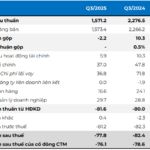As part of the Ho Chi Minh City Wood and Furniture Export Fair (Hawa Expo 2024), on March 7, 3034, the Vietnam Timber and Forest Product Association (VIFOREST) in collaboration with Forest Trends organized a workshop on “New Factors for Breakthrough in the Transformation of Vietnam’s Wood Industry”.
UNITED STATES IS THE LARGEST MARKET
At the workshop, VIFOREST announced the Comprehensive Report on Vietnam’s Wood and Wood Product Import and Export in 2023. According to the report, in 2023, Vietnam’s wood and wood product export turnover reached $13.18 billion, a decrease of 15.9% compared to 2022.
In terms of market, in 2023, Vietnam exported wood and wood products to nearly 170 countries and territories. Among them, the export turnover of the industry to the top 5 markets including the United States, China, South Korea, Japan, and the EU reached over $11.74 billion, accounting for more than 89.13% of the total export turnover of the industry. However, the growth rate to these markets decreased by 12% to 30% compared to 2022.
“Although the export turnover to most markets decreased, the export turnover to India and Indonesia increased significantly. In 2023, the export turnover to India reached over $122.02 million, an increase of 292.1% compared to 2022, and the export turnover to Indonesia reached nearly $86.63 million, an increase of 123.3% compared to 2022.”
According to the Vietnam Timber and Forest Product Association.
The United States is the largest market for Vietnam’s wood and wood product exports, with an export turnover of over $7.1 billion in 2023, a decrease of 16.3% compared to 2022, accounting for 53.9% of the total export value to all markets. In 2023, Vietnam exported a total of $6.38 billion of wood products (HS 9401 and HS 9403) to the U.S. – accounting for 90% of the total export turnover of wood and wood products to this market; the remaining 10% belongs to other wood and raw material products in HS 44.
China is the second-largest market, reaching over $1.73 billion, a decrease of 20.4% compared to 2022, accounting for 13.1% of the total export turnover. The main export items to China are wood and wood material products (HS 44) with an export turnover of $1.68 billion, accounting for over 97.2% of Vietnam’s total export turnover of wood and wood products to this market.
Japan ranked third with an export turnover of over $1.65 billion, a decrease of 12.5% compared to 2022, accounting for 12.6% of the total export value. The main export items to Japan are wood and wood material products (HS 44) with an export turnover of $1.27 billion, accounting for 76.9% of Vietnam’s total export turnover of wood and wood products to Japan.
South Korea is Vietnam’s fourth-largest wood and wood product export market, accounting for 6.1% of the country’s total export turnover. In 2023, the export turnover to this market reached $796.81 million, a decrease of 21.3% compared to 2022.
The EU is Vietnam’s fifth-largest export market for wood products and also a market with strict requirements on quality standards and legal wood sources. In 2023, Vietnam exported to this market reached $455.52 million, a decrease of 29.5% compared to 2022, accounting for 3.5% of the industry’s total export turnover. The main export items to the EU belong to the wood furniture group (HS 9401 and HS 9403) with an export turnover of $356.32 million, accounting for 78.2% of the total export turnover to this market.
UPHOLSTERED CHAIRS WILL BE THE “KEY FACTOR” FOR THE WOOD INDUSTRY IN 2024
Wood furniture, chairs, wood chips, veneer, and particleboard are among the top 5 commodities with high export value in 2023, reaching $11.91 billion, accounting for 90.4% of the total export turnover of the industry.
Vietnam’s wood furniture exports in 2023 reached $5.29 billion, a decrease of 22.5% compared to the same period in 2022; accounting for 40.2% of the industry’s total export turnover. Among them, the wood furniture sector (HS 9403.90) exported $1.04 billion, a decrease of 28.6% compared to 2022, accounting for 19.7% of the total export turnover of wood furniture.
For bedroom furniture (HS 9403.50), Vietnam exported $1.18 billion in 2023, a decrease of 18.7% compared to 2022, accounting for 22.5% of the total export turnover of wood furniture.
Kitchen furniture (HS 9403.40) had an export turnover of $970.26 million in 2023, a decrease of 8.2% compared to 2022, accounting for 18.3% of the total export turnover of wood furniture. In the office furniture group (HS 9403.30), the turnover reached nearly $254.27 million, a decrease of 28.6% compared to 2022, accounting for 4.8% of the total export turnover of wood furniture products.
“On the other hand, the export turnover of upholstered chairs reached $1.87 billion in 2023, accounting for 65.9% of the total export turnover of seating furniture. While most wood products experienced a decline in export turnover, the export of upholstered chairs increased by 9.1% compared to 2022. Upholstered chairs are considered one of the key factors for the wood industry in the coming years.”
According to the Vietnam Timber and Forest Product Association.
Vietnam’s export turnover of seating furniture in 2023 reached $2.83 billion, accounting for 21.5% of the industry’s total export turnover. Among them: Upholstered chairs (HS 9401.6100) reached $1.87 billion, accounting for 65.9% of the total export turnover of seating furniture, an increase of 9.1% compared to 2022.
Chairs with backs (HS 9401.6910) reached $9.5 million, accounting for 0.3% of the total export turnover of seating furniture, a decrease of 50.7% compared to 2022. Other types of chairs (HS 9401.6990) reached $539.9 million, accounting for 19.1% of the total export turnover of seating furniture, a decrease of 32.1% compared to 2022. The other parts of seating furniture (HS 9401.9099) reached $401.51 million, accounting for 14.2% of the total export turnover of seating furniture, a decrease of 12.4% compared to 2022.
The export volume of veneer reached nearly 1.12 million m3 and $219.92 million in value in 2023, accounting for 1.7% of the industry’s total export turnover. The export value of veneer in 2023 accounted for 6.7% of the industry’s total export turnover, an increase of 1.2% in volume but a decrease of 14.2% in value compared to 2022.
In 2023, Vietnam exported nearly 14.42 million tons of wood chips, reaching $2.22 billion, a decrease of 8.8% in volume and 20.4% in value compared to 2022, accounting for 16.8% of the industry’s total export turnover. China is the largest wood chip export market for Vietnam, followed by Japan and South Korea.
The total volume of exported particleboard in 2023 reached 4.67 million tons, equivalent to $679.59 million, a decrease of 4.3% in volume and 13.7% in value compared to 2022, accounting for 5.2% of the industry’s total export turnover. Vietnamese particleboard products were exported to 22 countries and territories in 2023, but the two largest export markets were South Korea and Japan.
In 2023, the export volume and value to these two countries accounted for 96.6% and 96% of Vietnam’s particleboard export turnover, respectively. In addition, the EU is the third-largest export market for Vietnamese particleboard in 2023, with a volume of 155.11 thousand tons and a value of $25.91 million, accounting for 3.3% of the volume and 3.8% of the value of Vietnamese particleboard exports to these markets.

At the workshop, in terms of new factors for breakthrough in Vietnam’s wood industry transformation, Dr. To Xuan Phuc, Executive Director of the Forest Policy Program at Forest Trends (USA), pointed out that domestic Acacia wood has the potential to replace imported risky wood sources, creating a breakthrough for Vietnam’s wood industry in the future.
The room to expand the use of Acacia wood is quite large. However, the use of Acacia wood for the transformation of Vietnam’s wood industry will not happen randomly but requires specific mechanisms, policies, and actions from management agencies and business communities in the industry.
According to Dr. To Xuan Phuc, currently, Vietnam imports about 2-3 million cubic meters of roundwood and sawnwood from tropical countries in Africa, Laos, Cambodia, Papua New Guinea, etc. These timber sources pose risks of deforestation and forest degradation, which have negative impacts on the image of Vietnam’s wood industry.
Currently, the country has about 4.5 million hectares of planted forests, of which Acacia accounts for about 70-80%, while the rest is concentrated in species such as white meranti, pine, and cajeput. The use of Acacia wood in the future could provide momentum for the transformation of Vietnam’s wood industry based on Vietnam’s efforts to expand planted forest areas.
First, the State provides financial and technical support to forest planters, focusing on planting and expanding large-scale certified Acacia forests.
Second, Acacia wood is increasingly popular, accepted by the market, and is currently widely used to make various products, including indoor and outdoor furniture, boards, wood chips, and particleboard. This type of wood is increasingly accepted by the domestic and export markets.





































